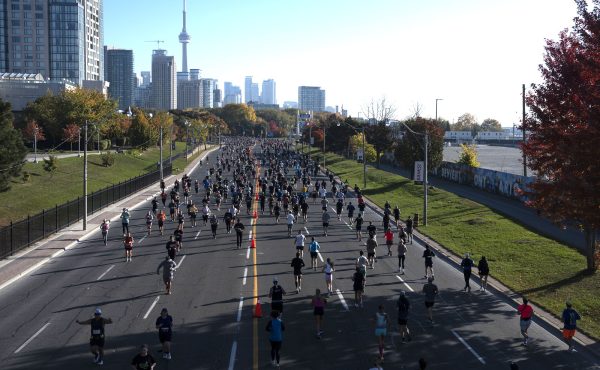
EDITORS NOTE: Nigel Terpstra, a moderator at Urban Toronto, has contributed this brief article about the need to get a high-quality pedestrian bridge for the CityPlace development in the railway lands.
Are pedestrian bridges merely pieces of infrastructure, meant to connect point (a) with point (b) over a void? Too often this is true; but engineers and architects who design footbridges will tell you that the best projects rarely focus solely on efficient and economic pedestrian access. Well-designed structures that still retain their bridge functionality can become destinations in themselves. And smaller structures provide more opportunity for affection since we use them directly, experiencing them first-hand rather than through a medium such as a car.
Some footbridges such as Melbourne’s Webb Bridge (2005) and Winnipeg’s Esplanade Riel (2003) have been both creatively designed and heartily embraced, fitting seamlessly into the city and crossing into the realm of urban furniture. Right now Toronto has the opportunity to create such a structure in a gateway location over the railway tracks just north of the emerging CityPlace development, west of downtown.
We Torontonians know the power of good bridge-building — the Humber Bay Bridge by local firm Montgomery Sisam Architects (1994) is proof. That structure’s two muscular arcs, suspending a wide and accessible pedestrian/cycle path beneath them, are an inspiring reminder that we live in a fantastic city with a vibrant design culture.
For the CityPlace bridge, however, CityPlace’s developer wants to saddle Toronto with a cheap and uninspiring box truss. For those unfamiliar with this terminology, a box-truss bridge is a simple box, framed in steel and often prefabricated off site. It is no coincidence that box trusses are one of the most basic and cost-effective bridge types available. There are already plenty of these structures plaguing Toronto so spotting a local example shouldn’t be hard.
A location this promising deserves more. A truly captivating bridge could create a ‘gateway’ to downtown while connecting CityPlace with Front St. and beyond to the north. Conversely, a dreary box truss would remind us that when we capitulate to private interests, costs are cut and everybody loses.
So, does a marquee bridge in a highly visible location on the edge of downtown, connecting an emerging neighborhood to a more established one while creating new vantage points from which to take in the surroundings, sound like a tall order? How about this: we want you to design it.
Bridging the Design Gap is a charette set up by members of the Urban Toronto Forum in response to the inappropriate box-truss design submitted to the city by CityPlace developer Concorde Adex. We are inviting talented amateurs and seasoned professionals alike to think outside the box-truss and create their own design(s) for the yet-unnamed bridge. Bridging the Design Gap is not an official competition to find a new design for the bridge, but a tool for stimulating discussion about what CityPlace could potentially do with this opportunity. This charette provides students with an excellent opportunity to show their skills while adding to their portfolio, while giving professionals an opportunity to demonstrate their creativity and innovation.
This threat is very real and your help is needed.
Click here for details including design requirements and submission guidelines.




4 comments
I like the Humber Bridge as much as anyone, but how many times more expensive is it than a box-truss bridge? The rail lands and Gardiner need a number of pedestrian/cycling bridges, and a number of ordinary ones, rather than one excellent one, will save more lives and move more people more easily.
This article discusses problems getting the GO Transit to agree to having the bridge built and the compromises they had to make in where the bridge is located.
I actually like the simple, unadorned functionality of a box truss bridge. Reminds me of Toronto’s industrial past and would be a nice complement to the Bathurst Bridge nearby.
Another article which mentions GO’s part in this:
http://www.thestar.com/living/article/234584